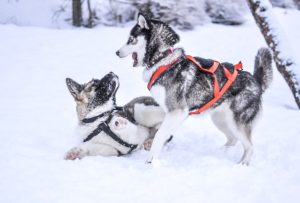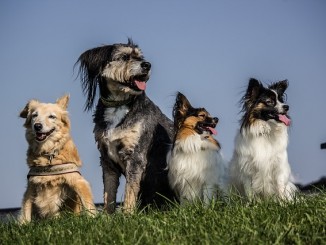
Siberian Huskies are among the most popular dog breeds in the world. They do not simply look cute; they also seem strong enough to protect their owners. After years of tending to my own Husky, I have proven that they are a breed that will never let you down. So, of course, we also would not want to let them down, ever.
One of my struggles back when I first had my Husky was choosing the right equipment or accessories. I wanted to make sure that I am not going to be too restrictive. At the same time, I also do not want my pet to go out of control. In short, I wanted to give him proper training; and the best way to do that without professional help is by using tools such as dog harness, dog collar, dog leash among others.
However, many dog parents— especially those who are just new in the game— are usually conflicted between a harness and a collar. So, we will talk about the difference between the two and when is the best time to use each of them.
 Getting to Know Your Husky
Getting to Know Your Husky
Before we even talk about harnesses and collars, it is first important that we know our Huskies very well. When we do, it will be easier for us to provide the best care they need. It will also help us understand their needs better, allowing us to attend to them accordingly.
Naturally, Huskies have been bred for pulling sleds in the cold. It goes without saying that they have a great stamina. More importantly, pulling is already a part of their natural instinct. Why is that so?
The Chukchi tribe bred Huskies about 3,000 years ago. The members of the tribe chose the strongest dogs. Particularly, they picked those that have strong tendencies to pull. They did this so that the dogs can help them pull heavy sleds under adverse weather conditions and through long distances. There is no wonder why Huskies are among the strongest dog breeds worldwide.
Now, as household pets, Huskies still bear these natural instincts. However, they do not have the avenue to utilize them fully. This is where the struggle comes in, which is why ample training is usually required. Otherwise, it would likely be difficult to control your Husky.
They were born as leaders of the pack. So, their pulling even intensifies when they are around other dogs. Huskies have this natural urge to set the pace. For this reason, it is even harder to assert your control over them. This is where and how accessories become helpful in the training process.
 Why Use a Dog Harness
Why Use a Dog Harness
A dog harness is an efficient training tool, especially for Husky puppies. It is the right choice when you want your dog to learn how to behave properly at a young age.
Further, It gives you better control over your dog as it discourages pulling and jumping. As an anti-pull device, it is really suitable for dog breeds with high pulling tendencies.
There is a certain type known as a non-pull harness. When your Husky pulls, the tension transfers to his or her body and not to the leash. This forces him or her to slow down. If that is not the case, your dog is forced to turn toward you.
With a harness, you do not need to worry about your dog choking. For this reason, it is your best bet if your Husky has respiratory problems or trouble breathing. Also, the risk of a neck injury is less than that of a dog collar.
Moreover, it also benefits injured Huskies. If your pet needs help moving around— to the point that he or she needs to be lifted, a harness comes in handy.
However, when using a harness, it is important that you remove it at the end of the day. It is not safe to leave it on your dog overnight as it could cause extreme discomfort. Huskies have quite long hair, which can get caught up in it.
When using a harness for your pet, be reminded not to yank on it. You would not want to risk injuring him or her.
Why Use a Dog Collar
A dog collar is the perfect companion of a dog leash. Typically and mainly, it is used when walking your Husky. There are some types or models intended to restrict dogs from pulling. Like a harness, it provides a negative reinforcement to correct such behavior or to control your pet.
It accommodates identification tags better than a harness. Also, your pet can move around more flexibly.
The problem with it is that it can cause neck injury, especially among those dogs pulling excessively. Since Huskies pull a lot, a dog collar may not be the best solution for them.
Since it is put around your Husky neck, there are also high chances that he or she might choke. This means that a collar is not also a suitable option for those with respiratory issues. When he or she pulls, the collar can stress his or her windpipe. So, even if your dog is not suffering from respiratory problems at the moment, he or she has greater chances of developing such.
Nonetheless, there are regular collars that do not restrict pulling. Of course, these do not address the problem but they are comfortable to wear. In fact, they are so comfortable that they can be left on your dog for days. There is no need to remove such collars at the end of every day.
In fact, if your Husky is already well-trained, a collar will do. You would not have to worry about hurting your dog’s neck since he or she is already well-behaved.
To Sum It Up…
 There are a lot of factors to consider when choosing between a harness and a collar for your Husky. Nonetheless, it all boils down to what he or she needs the most.
There are a lot of factors to consider when choosing between a harness and a collar for your Husky. Nonetheless, it all boils down to what he or she needs the most.
If you want to gain control over your pet and train him or her, you should use a harness as a training tool. If you are already through with this dilemma, then a collar is already enough as it provides a way to secure your pet’s identification tags.
Physical conditions also play a role when deciding which one to use. If your Husky has respiratory issues, then you should never let him or her wear a collar.
Attitude and/or behavior is another factor. If your Husky pulls excessively, it is better for him or her to wear a harness. If he or she pulls aggressively while wearing a collar, you would have no control over him or her. Your pet may also choke from the collar as he or she tries to pull away or jump.
A harness and a collar differ from each other greatly. They both have different functions and benefits. The most important thing is that you use the appropriate device that will address your dog’s needs at certain moments. So, it really matters that you know your Husky very well— from his or her nature to his or her developed behavior.
Are you using harnesses and collars properly? How did these tools help you and your Husky? Share your story! Who knows, you might just help fellow dog parents with their struggles.
Featured image courtesy of Pixabay.



Be the first to comment